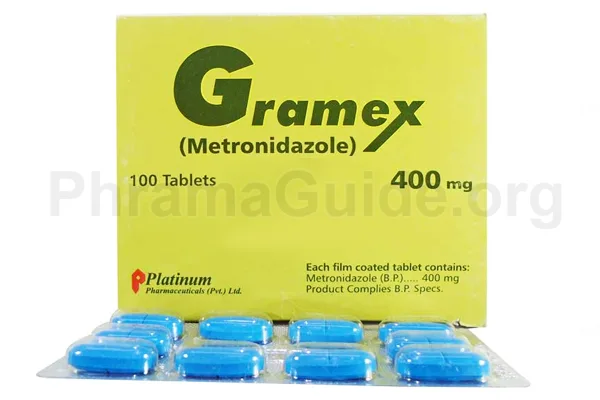Gramex tablet is an antibiotic medication that is used to treat various bacterial and parasitic infections such as intestinal, vaginal, and dental infections. Following are some approved and off-label uses of Gramex Tablet:
Approved Uses of Gramex Tablet
- Bacterial Infections: Gramex tablet is used to treat infections caused by anaerobic bacteria in various parts of the body, including the abdomen, skin, bones, joints, central nervous system, and respiratory tract.
- Protozoal infections: Gramex tablet is also used to treat infections caused by certain protozoa, single-celled organisms. It is particularly effective against infections caused by the protozoa Trichomonas vaginalis (such as trichomoniasis, a sexually transmitted infection) and Entamoeba histolytica (such as amebiasis, an intestinal infection).
- Bacterial Vaginosis: Gramex tablet is commonly used to treat bacterial vaginosis, which is an imbalance of bacteria in the vagina that can cause symptoms like vaginal discharge, odor, and itching.
- Helicobacter Pylori Infection: Gramex tablet is included as part of the treatment regimen for Helicobacter pylori infection, a bacteria that can cause gastric ulcers and other gastrointestinal conditions. It combines with other antibiotics and acid-reducing agents to eradicate the infection.
- Dental Infections: Gramex tablets may be used to treat dental infections, such as periodontitis (gum infection) and dental abscesses.
Off-label Uses of Gramex Tablet
- Crohn’s Disease: Gramex tablets can be used off-label as part of the treatment regimen for Crohn’s disease, a chronic inflammatory bowel disease. It helps to reduce inflammation and control symptoms in certain cases.
- Bacterial Overgrowth in the Small Intestine: Gramex tablets may treat bacterial overgrowth in the small intestine, a condition characterized by excessive growth of bacteria in the small bowel. It helps to control symptoms such as bloating, diarrhea, and abdominal pain.
- Diverticulitis: Gramex tablets can be used in the treatment of diverticulitis, an inflammation or infection of small pouches that develop in the walls of the colon. Gramex may be used as part of combination therapy to help control the infection and reduce inflammation.

What is Gramex?
Gramex is one of the leading brands of Metronidazole, manufactured and marketed by Platinum Pharmaceuticals (Pvt) Ltd, Pakistan.
Gramex Alternatives : Other Similar Brands
Below are some similar brands that can be used as an alternative to Gramex:
- Flagyl : Sanofi Aventis (Pakistan) Ltd.
- Metrozine : Searle Pakistan (Pvt) Ltd.
- Klint : Sami Pharmaceuticals (Pvt) Ltd, Pakistan.
- Riam : Stanley Pharmaceuticals (Pvt) Ltd, Pakistan.
- Abozole : Abbott Laboratories (Pakistan) Ltd.
- Metni V : Shaigan Pharmaceuticals (Pvt) Ltd, Pakistan.
- Metrida : Zafa Pharmaceutical Laboratories (Pvt) Ltd, Pakistan.
- Neometin : Genom Pharmaceuticals (Pvt) Ltd, Pakistan.
- Amezole : Ferozsons Laboratories Ltd. Pakistan.
- Danizol : Don Valley Pharmaceuticals (Pvt) Ltd, Pakistan.
- Flezole : Pearl Pharmaceuticals, Pakistan.
Gramex : Available Formulations and Strengths
Presently, Gramex is available in Tablet and Gel Forms with the following strengths.
Gramex Tablet : Metronidazole 400mg strengths
Gramex Gel : Metronidazole 1% w/w + Chlorhexidine 0.25% w/w strengths.
Who Should Not Use Gramex?
Gramex has certain contraindications, which are specific situations or conditions in which the use of Gramex is not recommended due to potential risks.
Hypersensitivity or allergy: Gramex is contraindicated in individuals who have a known hypersensitivity or allergy to Gramex or any of its components.
Blood disorders: Gramex can affect blood cells and may cause certain blood disorders. It is generally contraindicated in individuals with a history of blood disorders, such as blood dyscrasias or bone marrow depression.
Pregnancy and breast-feeding: Gramex should be used with caution during pregnancy, especially during the first trimester, as it may cross the placenta and potentially harm the developing fetus. It is generally contraindicated in the first trimester of pregnancy. It is also contraindicated during breastfeeding as Gramex can be excreted in breast milk and may harm the nursing infant.
Central nervous system disorders: Gramex can rarely cause central nervous system (CNS) side effects, including seizures and peripheral neuropathy. It is contraindicated in individuals with a history of CNS disorders, such as epilepsy or active seizures.
Alcohol consumption: It is contraindicated to consume alcohol while taking Gramex or within 48 hours after completing Gramex treatment. The combination of Gramex and alcohol can cause a disulfiram-like reaction, which may result in symptoms such as severe nausea, vomiting, headache, flushing, and rapid heartbeat.
What is the Recommended Daily Dosage of Gramex?
Gramex Dose for Bacterial infections:
- 1 to 2 tablets of Gramex taken orally three times a day.
- The duration of treatment may vary depending on the severity and location of the infection.
Gramex Dose for Protozoal Infections:
- Five Tablets (2000 mg) of Gramex taken as a single dose or divided into two smaller doses.
- In some cases, a longer treatment course may be necessary.
How Gramex Works?
Gramex exerts its mode of action by interfering with the DNA synthesis of susceptible microorganisms, leading to their inhibition and eventual death.

Leave A Comment